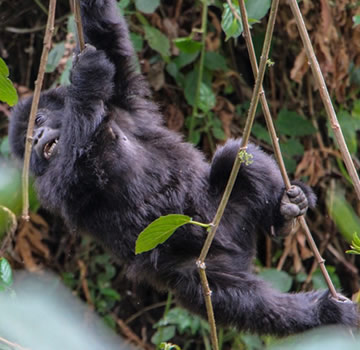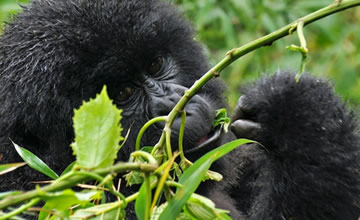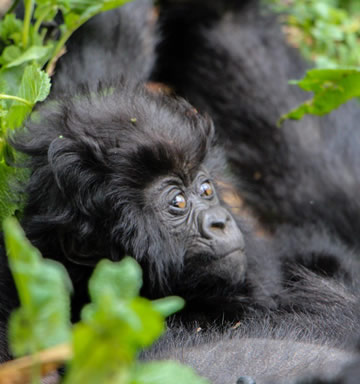Uganda is one of the 3 incredible destinations in Africa that offer refuge to the critically endangered mountain gorillas in the whole world. Over 550 mountain gorillas call Uganda their home which represents about half of the population that thrives in the entire world and this makes it one of the exceptional countries for gorilla trekking safaris in Africa.  Bwindi and Mgahinga Gorilla National Park are the only two national parks in Uganda where the rare mountain gorillas are protected and tracked on daily basis. Over 15 gorillas groups have been set for this lifetime experience. Each of the habituated gorilla families belong to respective trailheads in Bwindi except the one at Mgahinga They include, the Bweza, Busingye, Nshongi, Kahungye, Mubare, Rushegura and Habinyanja in Buhoma, Oruzogo, Kyaguriro and Bitukura in Ruhija and Nkuringo in Nkuringo and Nyakagezi in Mgahinga National Park,
Bwindi and Mgahinga Gorilla National Park are the only two national parks in Uganda where the rare mountain gorillas are protected and tracked on daily basis. Over 15 gorillas groups have been set for this lifetime experience. Each of the habituated gorilla families belong to respective trailheads in Bwindi except the one at Mgahinga They include, the Bweza, Busingye, Nshongi, Kahungye, Mubare, Rushegura and Habinyanja in Buhoma, Oruzogo, Kyaguriro and Bitukura in Ruhija and Nkuringo in Nkuringo and Nyakagezi in Mgahinga National Park,
Gorilla groups in Buhoma sector
Habinyanja gorilla family
Habinyanja gorilla group was habituated in 1996 and featured many gorilla members of about 25 with many powerful male gorillas. In February 2002 the family broke into 2 groups and hence the establishment of Rushegura group. This group is currently popular for moving to farther distances to the hill top and also colonizing new areas away from its initially known home range sites. Habinyanja group is comprised of over 17 members including one silverback, one blackback, five adult females, three juveniles, one sub adult and six infants. This group is led by Makara silverback.
Mubare gorilla group
This is another remarkable gorilla group in Buhoma sector which features as one of the oldest habituated gorilla group in Bwindi Impenetrable Forest National Park. It was habituated in 1991 but it completed its habituation in 1993 and it is exceptionally credited for single male silverbacks and pure intolerance to multi male leadership by its leaders. Historically, this family’s silverback-Ruhondeza was famous for practicing infanticide to remove younger males and at the time of Ruhondeza removal on 26th June 2012 only one lucky male-Kanyonyi had managed to live to the orders of his father and hence succeeding over his leadership. This family comprises of 15 members including one silverback.
It was habituated in 1991 but it completed its habituation in 1993 and it is exceptionally credited for single male silverbacks and pure intolerance to multi male leadership by its leaders. Historically, this family’s silverback-Ruhondeza was famous for practicing infanticide to remove younger males and at the time of Ruhondeza removal on 26th June 2012 only one lucky male-Kanyonyi had managed to live to the orders of his father and hence succeeding over his leadership. This family comprises of 15 members including one silverback.
Rushegura
This gorilla group was habituated in February 2002 after the previously huge Habinyanja group broke off. This family derived its name from tree species-Ebishegura which is situated within the area where the split took place. Rushegura group is known to forage near the park headquarters Buhoma and for venturing into the local community gardens around their home range. The group comes with 16 members, which includes also one silverback, four black backs, four adult females, four infants, three juveniles and it is led by Kabukojo
Rushaga area
Nshongi gorilla family
Habituation process for this group began in 2006. Before it comprised of over 32 individuals with multi males but as time went on, intra male conflict became intense which caused member separation. Early in 2013, 2 sections of this group broke away from the major Nshongi that led to creation of Mishaya group in June 2010 and later on the Bweza group. The unfortunate bit of it the Mishaya silverback passed on 3rd February 2014. This led to the dispersal of the remnant group individuals as they had no other adult male to lead them. Some of the individuals ended up joining Bweza group as the rest joined the Bikingi group. Nshongi group is comprised of seven members, one silverback, three adult females, one sub adult, one infant and one juvenile. This group is led by Bweza.
Busingye gorilla group

Gorilla individuals of this group formerly were habituated as a whole in 2008 together with Kahungye group, the unfortunately the family split in March 2012 forming the Busingye group. The group derived its name from one of the adult males who headed the splinter section to make a new group. This family is famous for foraging around the inner forest and rarely appears at the park edge. It is comprised of 9 members, with one silverback, three adult females, one adult female, four infants and one juvenile. This group is led by Busingye silverback gorilla.
Bweza gorilla group
This is formerly Nshongi group till early 2013 that its members broke off to make up their own under the leadership of Kakono. It likes venturing to the local community land than in the intact forest area. This seems like its way of them freeing from the original group. Bweza group is recently comprised of 12 members, which include two silverbacks, four backs, one sub adult, two infants and three adult females.
Kahungye family
Originally, had over 29 individuals with 3 adult males but as a result of intra male fights, split took place in March 2012 forming the Busingye group. Currently, this group is made up of 17 members including three silverbacks, three black backs, three adult females, three sub adults, and three juvenile and 2 infants. Habituation process for this group began in 2008.
Mishaya gorilla group
This was part of the Nshongi group in 2010. Mishaya is known as a fighter which broke off from the prime group with 10 individuals and he has kept on fighting the rest of groups while also succeeding other gorilla members. It is currently 12 members and one silverback.
Ruhija sector
Bitukura group
Found in Ruhija trailhead in Bwindi Impenetrable Forest National Park, Bitukura is led by Ndahura and it is made of 13 members, four silverbacks, four adult females, two juveniles and infants. Its habituation process began in 2006. It is one of the tolerant groups where over 5 adult males can be thriving within the same group.
Kyaguriro A and B groups
The Kyaguriro A and B families are entirely set for research in Bwindi Impenetrable Forest National Park. The family’s habituation started in 1995 following the sadden death of the principal group leader Rukina succumbed to an electric shock as a result of lightening on 7th April 2015. After Rukina died, this group was then led by inexperienced young silverback Mukiza who was later ambushed by an immigrating adult silverback-Rukara from the Bitukura group and which fueled a break off the group into 2 and hence Kyaguriro A (Rukara and Kyaguriro B-Mukiza in May 2016. The break off of these groups isn’t that assured as the two sub groups have kept on meeting around the park and the whole group is famous of spending nearly all the time in the inner forest. Rukara is made of 10 members, one silverback, two black backs, three adult females, two juveniles and two infants and Mukiza also comes with ten members that include one silverback, four adult females, one sub adult and four infants.
Oruzogo group
This is another amazing gorilla family that you must visit while on safari in Bwindi Impenetrable Forest National Park. It is led by Bakwate and comprised of 17 members, which include the two silverbacks, two black backs, five adult females, two sub adults, one juvenile and five infants.
Nkuringo group
This family is made of 12 members with two silverbacks, one black back, two adult females, two sub adults, two infants and three juveniles. This group is situated within the Nkuringo sector and was first gorilla family to be habituated in the whole southern area of Bwindi Impenetrable Forest National Park in 1997. Before, this gorilla troop had 17 individuals but as time went on others broke off and hence the current number. The group also features as the first gorilla family to register the twin gorillas in Bwindi in December 2004. This group is led by Rafiki

Bikingi group is also situated within this sector but still undergoing habituation process. This group one of the two gorilla families set for gorilla habituation experience in Bwindi, a tourism product which is rare you can’t get anywhere in the world except only Bwindi in southwestern Uganda. This group is made of 15 members with one silverback, five adult females, two sub adults, two juveniles and five infants.
Bushaho group
Like humans, gorilla groups also split, some of the individuals in this group are from Nkuringo group. It is also set for Gorilla Habituation Experience in Uganda. Unlike the usual treks, habituation experience allows visitors to spend four hours with the apes in their natural habitat. This group is led by Bahati and mainly made of eight members with one silverback, one black back, three adult females, one sub adult, one infant and one juvenile.
Nyakagezi gorilla group
This is the only gorilla group which is set for gorilla trekking in Mgahinga Gorilla National Park. It is led by Mark and features ten members, five silverbacks, two adult females, one infant and two juveniles. Habituation process for this family began in 1991 and was later set for gorilla trekking in 1994. It is also known for its migratory behavior across the border between Uganda and Democratic Republic of Congo but at a moment the group has settled and can be tracked in Mgahinga Gorilla National Park.
In conclusion, gorilla trekking is only enjoyable in habituated gorilla groups. Bwindi Impenetrable Forest National Park features 11 groups for gorilla tourism and only 1 is found in Mgahinga National Park for gorilla trekking.
